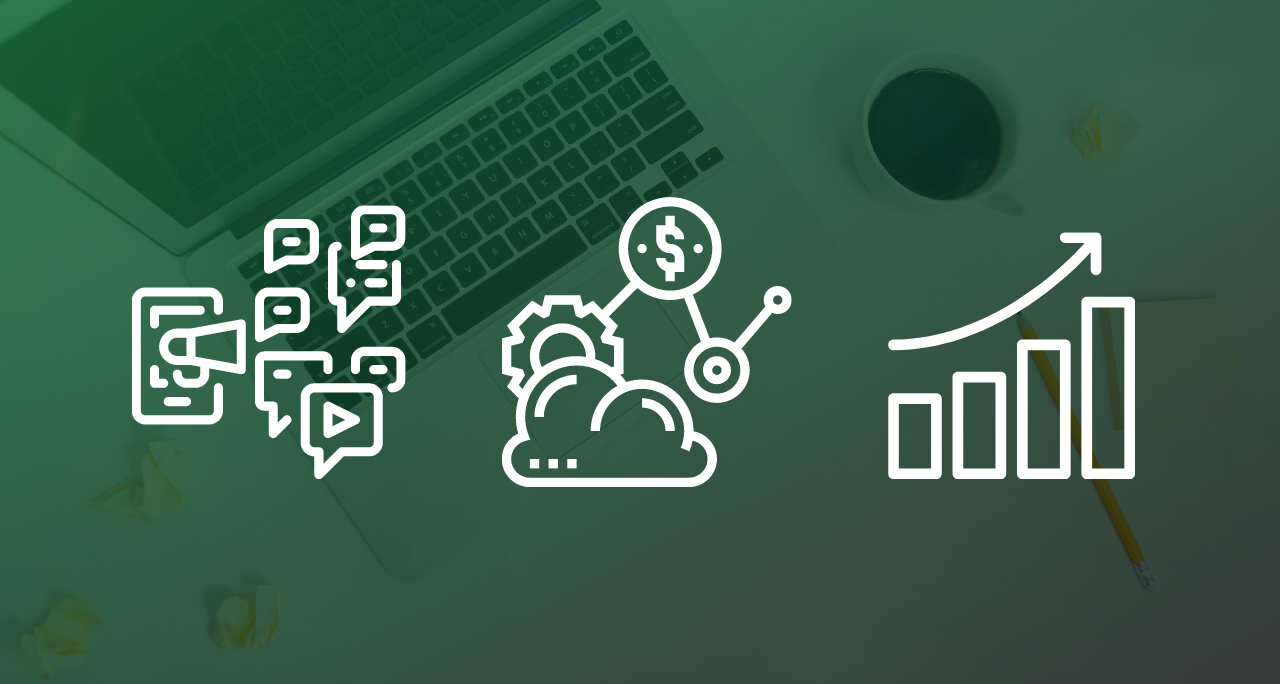As SaaS growth continues to soar, companies which sell software as a service have numerous opportunities at their fingertips – but almost as many challenges.
From getting traction in the market, standing out from the competition, and meeting and exceeding their customers’ expectations, businesses need carefully crafted growth strategies now more than ever.
Our recent fireside chat with SaaS experts Eduardo Esparza, CEO and Founder at Market8, and Pedro Magriço, Senior Product Manager at Hotjar, and former Head of Growth at Typeform, provided an overview of the growth strategies that product-led companies are using today to meet these challenges.

Let’s talk about Trends: There’s a lot of interest and growth in the SaaS space, particularly in the product-led model, with the app doing the heavy lifting of driving growth. What are your thoughts on the major trends that are impacting this segment?

“The worldwide economy is expected to continue to grow at a faster rate post-pandemic,” Eduardo pointed out. With this, he emphasized, comes an increasing trend towards product-led growth and a focus on enabling customers to experience solving their problems within the product instead of explaining how to solve those problems.
“Another trend is that SaaS companies want to have a greater understanding of their customers. As a result, solutions are increasingly addressing very specific problems and are solving those very, very well, as opposed to a broader approach,” he said.

Pedro added to this, saying that SaaS is no longer “new and novel,” but as product-led growth has been more of an emphasis it has also become clear that “this is a discipline,” which has evolved from the previous “growth hacking” tactic.
“Opportunities for growth don’t come as easy as before, and not everyone can be a Zoom or a Slack,” Pedro pointed out. Companies like these, he said, had very strong collaboration and were inherently viral, and this is the case especially when there are only a few companies on the market.
A takeaway here would be not to obsess over exclusive product-led growth. Support and professional services have their place and should be used along with the product.
Challenges: Let’s talk a bit about the challenges aspiring product-led companies face today, as they strive to grow.

“Before, to set up an online company was so hard, but now it’s easier because of everything that is available on the market in terms of tools and infrastructure. The no-code movement also helps here getting a company started faster,” Pedro reflected. “There has been an explosion of tools and products—in fact it’s overcrowded—and the challenge is to stand out. There’s also the pressure of time-to-market.”
“Companies that spend a lot of time perfecting products that solve a big pain point, in a uniquely differentiated way, will be the most successful,” Pedro added.

Eduardo pointed out what to look for in a successful product: “Is it a solution that really solves a problem that matters enough to the customer? Only after that can you can move up the funnel and see how many customers are actually activating, focus on acquisition, and so on,” he added. “The key challenge is just to get focused on the right stage of the funnel.”
When you have a lot of churn because your product is not the right fit, and you pour money into acquisition, you get into the spiral of death. This is something that you need to avoid as a start-up.
Opportunities: How can a company find growth opportunities?

Eduardo expressed it simply: “Understand the customer really, really well, and unify your team and your organization around a specific set of metrics: actionable metrics.”
At Market8, Eduardo shared, they compile a single spreadsheet with key steps of the journey in terms of the metrics involved—traffic, acquisition, activation, referral, etc. By tracking those metrics, they determine where the bottleneck is and focus their efforts on that stage of the funnel.
A methodology for this is the Jobs to be Done framework which will guide you towards understanding if your product is meaningfully solving a problem, Eduardo shared. The JTBD homework will uncover innovation opportunities – you will easily see gaps that you are not covering today or are underserved. Then you can work on articulating your differentiators, on your positioning, he explained. You also need to establish your user analytics with a product analytics tool – Mixpanel, InnerTrends, Amplitude, are tools SaaS should have in mind to keep track of those key metrics, Eduardo added.

Pedro agreed, adding “You have to talk to your customers, not just look at the quantitative side, the ‘quants.’ I have one customer interview a week. And this is not just about your product. Understand what their pain points are. How does the customer make decisions? What is the job mission? That’s how we determine how to prioritize and how our product can help.”
Metrics: What metrics are important at each growth stage? What KPIs are you keeping your eye on?

“There are a few table stakes metrics to keep your finger on the pulse of the health of a business, like customer churn, revenue churn,” shared Eduardo. “Look at your K-factor to understand the extent to which referrals work for you; this would be a measure of virality. Customer lifetime value (CLTV), Customer Acquisition Cost (CAC), Payback period (PB), CAC/CLTV ratio. Then, you should be looking at conversions along the funnel: trials, onboarding steps, all the way to Annual Recurring Revenue (ARR), or Monthly Recurring revenue (MRR).”
“That’s the base of metrics. Then, for each growth stage there are differences – at the beginning, the entire focus of your team should be on retention and that’s where your North Star metric should be. Make sure the customers are using and enjoying the product; this is the bottom of the funnel. Then move upwards as the product evolves and you get market validation,” he added.

Pedro agreed with Eduardo, adding some tips: “Analyze retention in the context of the natural usage cycle of your product. Then look at correlation between features, long-term value, and user segmentation to understand more about what leads to retention.”
“Early adopters are more tolerant and stick around. Late majority, mass-market customers have less patience,” he added. “Conversion rates, retention rates, user happiness all trend downward as you evolve.”
Virality: What about companies who don’t have the advantage of embedded virality (like Zoom or Calendly). What is their recipe for becoming viral?

Eduardo started by pointing out that some products have embedded virality; with those, he said, you obviously “have the upper hand.”
“You just have to leverage the touchpoints . . . make sure users get exposed to the materials signing up.” Then, after the users experience the product for a period of time, he said, others in their network are naturally exposed to it.
Eduardo also referred to “contextual virality,” which is a form of referral to boost growth. Hotjar is a great example here, where they invited people to new features on waiting lists and were amazing at the resulting interest they captured.
“Incentivized virality” can be effective, and hinges on offers that include motivations like “Invite X number of new people to benefit from this feature for free.” A great example of this approach is DropBox.
Another type is “exposure virality,” with products like Duolingo, Strava, and Peloton, which Eduardo also calls “prestige virality.” Users want to share their prowess and show off to their friends, and this naturally leads to word-of-mouth exposure.
Bottom line, Eduardo emphasized: “Every SaaS has some opportunity to get exposure that is not limited to embedded virality. You have to come up with creative alternatives to this.”

Pedro agreed, adding that “very few companies have that true exponential virality – except maybe social networks, messaging apps. The best companies have multiple growth levers and keep experimenting with new channels.”
Freemium & Upgrades: How can a product-led SaaS business make the most of their freemium opportunities? What are the pitfalls to avoid and what have you seen that works best to upgrade your customers to a paid or higher package?

Pedro emphasized that businesses should experiment with different tactics to see what works best – free trials, trial with credit card details upfront, freemium, etc. “I know companies that initially had free trial and then experimented with freemium, and it worked much better.”
“Having a button that’s marked ‘Talk to Sales’ – that’s too much friction,” he adds. When companies first start out, it makes sense to offer a free product at the beginning, but then, inevitably, they are pressured to grow and go up-market . . . and then a better product comes along with a free version, and the cycle continues.”
“Embrace freemium as an acquisition channel,” he added, “Not a free-for-all offering. It should give a taste of the product.” Making sure your upgrade paths are optimized for conversion was another key takeaway from this discussion.

Eduardo added “When there are a lot of contenders out there, obviously you want to disrupt and get some noise, and the free trial looks really attractive, a way to enter the market. Over time you figure out how to monetize that, how to move the dial between free features and paid.”
“You have to consider your users,” he continued. “If the curve of adoption is such that you need more commitment, you don’t want to do freemium because you won’t have a lot of engagement there. A paid trial would make more sense here.”
Churn: What are the best ways to fight churn?

“You have to go back to the basics,” Eduardo emphasized. “You have to have a really good understanding of how people are using the product – both the qualitative and the quantitative parts of it. The quantitative area will tell you were to look, and then for the qualitative part, you need to actually speak to your customers. You can also use more sophisticated tools, such as product analytics, to find the sticking points.”

Pedro added that it’s important to talk with those customers who churn, to send a survey as a first step, have a more personal approach – “from the founder” – and do whatever it takes to get that feedback. “They committed to your product, had certain expectations, and yet they churned. You need to know what happened. You need feedback. You’ll see patterns.”
Another point worth considering is which customer segments are churning. You might be trying to acquire the wrong type of customers, so they will be more likely to churn. If you know your product resonates with a certain kind of customer, target them. Find ways to be more targeted with your acquisition channels. Casting a wider net is not always helpful, because acquisition and churn go hand in hand. The more you try to dial up on acquisition, the more churn you’ll have, Pedro points out. This is where positioning comes into play – fine tune your messaging and how you articulate your differentiators to appeal to the right target market you want to attract.
Monetization is a huge growth lever; pricing changes, if driven by added value and innovation, are perfectly okay to do and very justifiable, mentioned Eduardo.
How often should you change your pricing? much more often than you are thinking,” Pedro said, which nails the importance of looking at this from a strategic perspective.
A particular aspect of this is grandfathering early adopters – is that a recommended option, or would changing your pricing for everyone lead to churn for those first brave customers?
Pedro’s opinion here is very clear-cut: “You should never grandfather forever.” The argument is that supporting different versions of the product is messy, and in time, the reality is that your products adds more and more value, so the users – whether they are early adopters or not – will appreciate that and if the price is right they will be willing to pay for it.
A best practice to elegantly solve this issue is giving a grace period – let’s say six months , or a discount for a limited time – to show your gratitude for those early adopters, while at the same time simplifying your life and being able to be forward thinking, Pedro added.
Also, tackle voluntary and involuntary churn in different ways as they are very different beasts. Involuntary churn can be addressed with specific revenue recovery tools – account updaters, retry logic, and so on – as it is related to card decline and has nothing to do with clients not wanting to continue using your service.
Going Global: What are your thoughts on localization?

“We’ve always prioritized English first, but the market is getting more crowded,” Pedro pointed out. “The global players may overlook those smaller markets, but they may be big enough and attractive for a start-up.
“You can grow faster there because you’re building your product for a more targeted customer base, so these non-English speaking markets could be very attractive,” he added.
Tools: What are the tools that the product-led company should not do without?

“You want to have at the core a user-based analytics platform. You want to understand user behavior and how they are using your product,” emphasized Eduardo. He added that it’s important to pull all your data into one place so you can track your performance and discover insights in real time, and then assign accountability for different metrics to members of your team for the KPIs.
You have your tech stack, he added, but it’s important to know who owns those metrics and are accountable for them – the tools on their own don’t add much value, it is how you use them as an organization that will make a difference.
Pricing and retention solutions, behavioral analytics, optimization platforms (A/B testing), as well as the classic CRMs, marketing automation, email, and conversational marketing are other tool categories mentioned as being useful for a product-led company.

Pedro added that each tool has its own set-up that adds friction and recommended using a data hub (a customer data platform) such as Segment; “you send all the data, you install it once and then Segment takes care of pouring all the data to the downstream tools. It’s more reliable and you lose less time, and the same data is available across the organization.”
To experience our fireside chat firsthand for all the insights from Pedro and Eduardo, watch the full webinar here.






